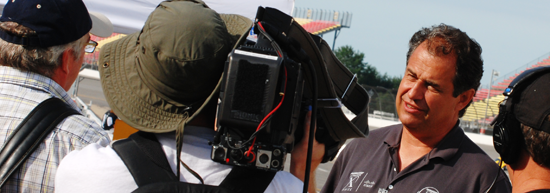Media
This section contains quick facts and high resolution photos for the media. Please contact us if you are interested in any other material or information.
• For the Progressive Insurance Automotive X Prize, Edison2’s founder and CEO Oliver Kuttner assembled an elite team from professional motor racing, with over 20 victories at Le Mans, Sebring and Daytona. Northrop Grumman’s aerodynamics fellow Barnaby Wainfan, who met Edison2’s Chief of Design Ron Mathis through the Audi Sport North America R10 program, designed the shape of the X Prize winning Very Light Car.
• The breakthrough efficiency of the Very Light Car comes from the fundamental principles of light weight and low aerodynamic drag. With the lowest coefficient of drag, 0.160, ever recorded at the GM Aero Lab (for a multi-passenger vehicle), and with the best coastdown numbers ever demonstrated at Chrysler’s Chelsea Proving Grounds, the Very Light Car simply requires little energy to move. For example, only 5.3 hp is needed to cruise at 60 mph.
• While Edison2 won the X Prize with an internal combustion engine, the electric Very Light Car has set a new standard for electric car efficiency. Needing only a 10.5 kWh battery pack to achieve a 100 mile range, the eVLC recorded 245 MPGe (EPA combined), compared to 99 MPGe of the Nissan Leaf. The battery pack fully recharges in less than 7 hours, using regular household 110V outlet. The electric Very Light Car successfully addresses the issues holding back electric cars: range, battery cost and charging time.
• The Very Light Car is extremely light. Light-weighting becomes a virtuous cycle, with a lighter chassis needing a smaller drive train, a lighter suspension and so on. Every component is evaluated for function and redesigned with an eye to simplicity, strength and low weight. For example, brake calipers that usually weigh several pounds are less than one pound; lugnuts are 0.2 instead of 1 ounce.
• Edison2 is showing that a low-mass car can be a safe car. Innovations derived from racing enhance safety in the Very Light Car. These innovations include collapsible space not available in current cars (such as wheels outside of the main body structure) and a shape that deflects rather than engages on impact. Preliminary computerized crash simulations and an initial crash test are validating this approach.
• Underlying the efficiency, safety and handling of the Very Light Car is a new automotive architecture. A patented in-wheel suspension allows an uncluttered design with only 4 structural connection points (instead of the 12 or more in conventional designs), reducing weight and improving packaging. Wheels external to the frame allow superior aerodynamics and create new crush zones for passenger compartment integrity.
• The Very Light Car embraces sustainability. Not just efficient to drive, but cradle-to-grave environmentally responsible. Less mass means fewer material inputs. Energy intensive and hazardous or scarce materials are largely avoided in favor of conventional materials, like aluminum and steel, that are readily available, easily made in volume, and completely recyclable. Low-mass vehicles have other environmental benefits as well, such as less wear on tires, brakes and roads.
• At heart the Very Light Car is a simple vehicle, avoiding the feature creep that has loaded down contemporary vehicles. The combination of design simplicity, low mass and conventional materials means the Very Light Car will be not just inexpensive to drive but affordable to buy.
Edison2 can be followed on Facebook, Twitter (VeryLightCar) Youtube (VeryLightCar) and blog (edison2.com/blog).


